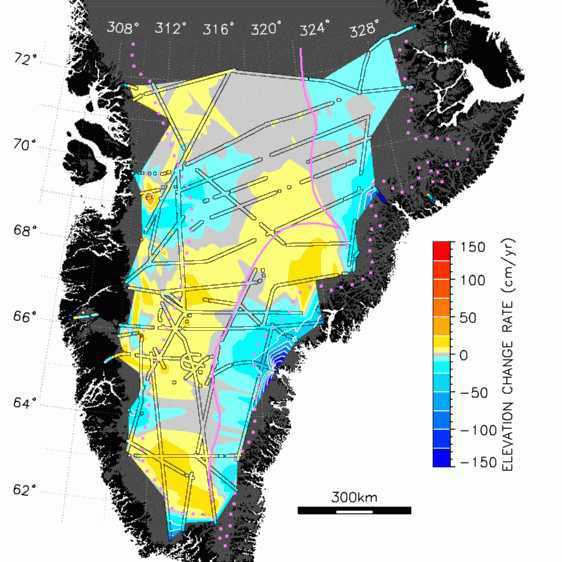Greenland's ice sheet
|
E. Linacre and B. Geerts |
4/'99 |
![]()
Very little is known about changes in the vast volume of ice resident on the polar ice caps. Yet such knowledge is important, because if all the ice on Antarctica and Greenland were to melt, it would cause a rise in global sea level by nearly 70 m.
A recent study shows that Greenland's southeastern glaciers are thinning and that their lower elevations may be particularly sensitive to climate changes (1). The assessment is based on airborne laser altimeter data, and on detailed geolocation information by the global positioning system. A series of flights were conducted in 1993 and again in 1998. Little change in ice sheet elevation occurred on the plateau. Some large internal areas of Greenland showed some ice thickening (Fig 1), up to 1 m in 5 years. These areas receive heavy snowfall, over 1,500 mm of rain-equivalent per year, and an interannual variation of 1 m snow depth is readily achievable. In other words changes in the local ice budget (snow accumulation minus melt-off) were too small to be measured.
Large changes did occur along the perimeter of the ice sheet, suggesting an increased ice discharge rate of outlet glaciers in southeast Greenland. An outlet glacier acts as a major ice drainage for an ice sheet. The increasing discharge speeds of some glaciers flowing into the Atlantic Ocean has resulted in a thinning of the drainage area (part of the low-elevation ice sheet) by up to 10 m between 1993-98.
The excess volume of ice transported by these glaciers has a negligible effect on global sea level, but if it accelerates or becomes more widespread, it would begin to have a detectable impact on sea level.
The cause of the increased glacier discharge is not clear. Surface-melt water might be seeping to the bottom of glaciers, which may reduce the friction between the ice and the rock below it, enabling the glaciers to slide with less friction across the bedrock and thus allow more ice to slip off into the ocean. This might indicate that the coastal margins of ice sheets are capable of responding quite rapidly to external changes, such as global warming.
Fig 1. Changes in the elevation of the ice surface in south Greenland between 1993-98. Aircraft tracks are shown as roads (1).
The 3 stations along the southeast coast of Greenland reported warmer-than- normal temperatures for 1993-1998. However some ice thinning also occurred near the southwest coast, where many locations were cooler than normal.
To better document polar ice-level changes, a laser altimeter will be deployed on a satellite (Icesat), scheduled to be launched in 2001.
.
References
(1) Krabill, W., E. Frederick, S. Manizade, C. Martin, J. Sonntag, R. Swift, R. Thomas, W. Wright, and J. Yungel, 1999. Rapid Thinning of Parts of the Southern Greenland Ice Sheet. Science, 283, 1522-1524. (also visit the Greenland Mapping Project)
